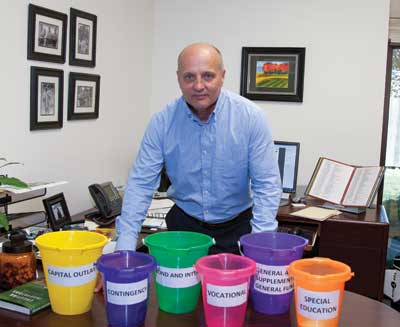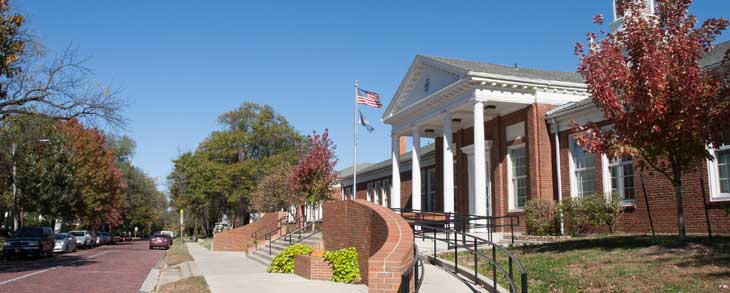Third Quarter 2012
story by DAISY WAKEFIELD
photos by STEVEN HERTZOG
Funding the School District
 If reading, writing and arithmetic are at the heart of education, then the running of the local educational machine like Unified School District 497 is much of the same, just more complicated.
If reading, writing and arithmetic are at the heart of education, then the running of the local educational machine like Unified School District 497 is much of the same, just more complicated.
Based on fund accounting practices, the school district’s budget is categorized into seven tax levy funds: General Fund, Supplemental General Fund (Local Option Budget), Adult Basic Education Fund, Cost of Living Fund, Capital Outlay Fund, Bond and Interest Fund and Special Assessment Fund. There are also Special Revenue Funds, which are non-levied funds. The total budget for 2012-13 school year is approximately $141 million, an increase of about 12% from the last school year.
Each of the funds are specific for what they may pay. The General fund is the largest and goes toward salaries, utilities and general operational costs. The Local Option Funds are supported by a local mill rate and have a State regulated cap of 31% of General Fund amounts. Some of the Special Revenue Funds come from federal monies, such as that for special education, bilingual education, food service, and Title 1, a designation of educational funding for higher poverty populations.
Some of the funds are formula-derived by the State, which can change from year to year, and are largely influenced by availability of tax dollars as well as political ideologies. With K-12 education accounting for 50% of the state budget, it is the most influential piece of the state budget puzzle. It is also the most vulnerable, at the constant mercy of cuts.
Cuts All Over
In the middle of the 2009-2010 school year, when budgets and teacher salaries had already been set, word came down from the State that $3 million had to be cut from the Lawrence school district’s state funding. There was no choice but to take a knife and start slashing. Talks started of closing one or more elementary schools to realize cost savings. Parents formed ad hoc community protests. Sixth-grade band members flooded a school board meeting to object to their activity being cut.
Per pupil funding had decreased for 4 years, until this school year when $58 per student was added back. Still, that figure puts per pupil state funding at pre-2001 levels.
“When tax dollars went down during the great recession, we got cut,” says Rick Doll, Superintendent of USD 497. “We thought that when the tax dollars increased, we would get some cuts restored, but that hasn’t been the case.”
For Lawrence school district, the cuts have been drastic. Class sizes have increased while programs have been reduced, and service and support staff positions such as nurses, counselors, librarians and administrators have been consolidated. Wakarusa Elementary was shuttered at the end of the 2010-11 school year, decreasing the number of elementary schools to 14.
To Spend or To Save?
 Doll’s concern presses on him even more since recent tax cuts passed through the legislature. The Governor asserts that the tax cuts will boost the economy by creating jobs, and that services to schools will not be affected. However, an independent research study by The Kansas Legislative Research Department, lays out a bleak picture in which the state will go into deficit by mid-2014, and be $2 billion in deficit by 2018. If this proves to be true, it will have a pernicious effect on education in Kansas.
Doll’s concern presses on him even more since recent tax cuts passed through the legislature. The Governor asserts that the tax cuts will boost the economy by creating jobs, and that services to schools will not be affected. However, an independent research study by The Kansas Legislative Research Department, lays out a bleak picture in which the state will go into deficit by mid-2014, and be $2 billion in deficit by 2018. If this proves to be true, it will have a pernicious effect on education in Kansas.
The school district is currently between, and the school board has pounced on the opportunity to add and replenish. In April, the Board voted swiftly to add $2 million in programs and positions. Full-day Kindergarten was given to the remaining four elementary schools that did not have it. Class sizes in elementary and middle schools were decreased and 21 teacher positions were added to the district. The Board also voted to reinstate the director of instruction, a position that had been cut in previous years.
Even as the Board spends currently available money, administrators know the other shoe can drop at any time. Doll is upfront about his pessimism that the tax cuts will work in favor of educational funding.
“We’re spending down some of our savings, which is not unlike spending down your personal savings,” Doll says. “If your income source is constant, and you expect it to be constant or increase, then spending down some savings is not a big deal. But we don’t know our funding stream from year to year, and what we should be doing is increasing our savings.”
Politics
Part of the problem with increasing savings, however, is that politicians are putting pressure on school districts to spend down their fund balances. The current political climate is that the savings of the districts is too cushy, and they can afford to dip into them. Previous to 2007-2008, schools were allowed a maximum of 6% of General Fund balances to be kept in Contingency Funds. State legislature approved a temporary increase in the maximum to 10%, but in 2011, the State wanted to go back to 6%, which meant that the Lawrence school district had to spend down savings by about $3 million. Ultimately, a bill passed allowing school districts to keep the maximum at 10%.
“We don’t get our state funding until December or January of every school year,” Doll says. “That means we have to operate for 4 to 5 month on savings, until that funding comes through.”
Other political maneuvering for K-12 education is the effort to increase the maximum for the Local Option Budget Fund. Currently at a maximum 31% of General Fund, the LOB allows school districts to raise money through property tax mill levies. While many think an increased maximum would be good news for districts like Johnson County and potentially good for the Lawrence school district, it raises questions of equity for poorer districts, especially in urban and rural areas.
Looking Good… For Now
 Currently, things are pretty good for the school district’s finances. Some money has been realized from increased enrollment and more at-risk dollars. Salaries for teachers have been set for the year, though there were a few tense weeks of negotiations. The mill levy was decreased slightly in July. And for the first time in 3 years there is no talk of consolidating elementary schools.
Currently, things are pretty good for the school district’s finances. Some money has been realized from increased enrollment and more at-risk dollars. Salaries for teachers have been set for the year, though there were a few tense weeks of negotiations. The mill levy was decreased slightly in July. And for the first time in 3 years there is no talk of consolidating elementary schools.
Instead, there is talk of a bond issue to be put to vote in April 2013. This would be a “no tax increase” bond issue, as other bond and interest debt is due to be retired. The bond issue would be used primarily to fix long-ailing issues in the elementary buildings, especially in the 6 central and east Lawrence schools: Cordley, Hillcrest, Kennedy, New York, Pinckney and Sunset Hill. Beyond that, bond money could be used for ADA compliance and removal of portable buildings at all the elementary schools and addition of areas in the high schools.
“Over the next several years, we’ll have about $110 million that we could fund without a tax increase,” Doll says optimistically. “We’re very confident that we can do a no tax increase in the bond issue. So I’m optimistic that it will pass. Not cocky, but optimistic.”
NOTE: Daisy Wakefield served on the Central and East Lawrence Elementary School Consolidation Working Group from June 2011 to March 2012.
